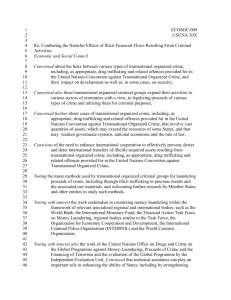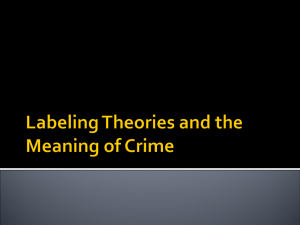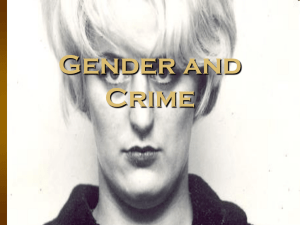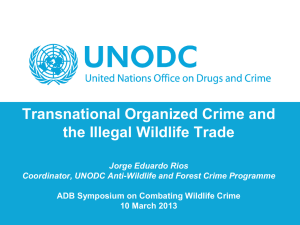Transnational Organized Crime
advertisement
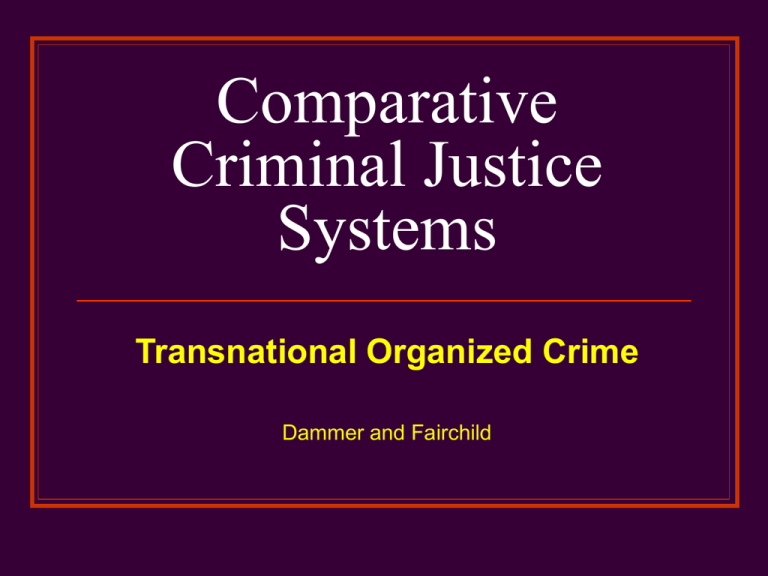
Comparative Criminal Justice Systems Transnational Organized Crime Dammer and Fairchild Transnational Organized Crime A continuing criminal enterprise that rationally works to profit from illicit activities that are often in great public demand. Its continued existence is maintained through the use of force, threats, monopoly control, and/or the corruption of public officials. Entrepreneurial Rationale “ Like legitimate business, transnational criminal enterprises are embracing globalization by adopting new communication and transportation technologies which allow them to pursue global markets.” (Center for Strategic and International Studies, 2001) Transnational Crime Problem Worldwide Major issues creating the rise of transnational organized crime: Globalization of the world economy, i.e., downfall of the Soviet Union and the switch to a free-market economy in China Emerging democracies Economic independence throughout the world Opening of the borders for trade and travel Seamless electronic environment The Scope of Organized Crime Organized crime involves two types of activity: Provision of illicit goods and services and/or Infiltration of legitimate business Provision of Illicit Goods and Services (Enterprise Syndicates) Traditional Activities: Harm Consensual Activities* No Inherent Violence Economic Harm * Between the organized crime group and the customer. Gambling, loansharking, prostitution, narcotics, stolen property Contemporary Activities: Theft of intellectual property, illicit arms trafficking, money laundering, and trafficking in persons Infiltration of Legitimate Business (Power Syndicates) Traditional Activities Harm Nonconsensual Activities Threats, Violence, Extortion Coercive use of legal businesses for purposes of exploitation Contemporary Activities Economic Harm Bankruptcy fraud, insurance fraud, extortion by computer Violence The use of violence occurs as either a part of an extortion scheme or else to enforce “agreements.”* Threats and actual violence have several objectives: Intimidate outsiders Terror/fear directed at potential informers Discourage competition Settle disputes * Agreements to provide illegal products cannot be enforced in court. Organized Groups Pre-existing social or culturally-based groups: Groups that have ongoing hierarchical structures from “bosses” to “soldiers,” longstanding criminal activities due to their influence in a local area, socialize as a group and engage in neighborhood life apart from crime, i.e., Mafia groups, Yakuza. Groups that emerge to exploit a specific criminal opportunity: Entrepreneurial, small, inter-ethnic ad hoc groups with limited hierarchy and limited group cohesiveness. Networking among groups occurs when needed to carry out a criminal activity, i.e., Russian Mafia, Ukraine, and South African groups. Selected Regions and Transnational Crime EUROPE: a continent in transition with the European Union (EU) expanding from 15 to 25 countries. EU member states report the existence of 4,000 organized crime groups with approximately 40,000 members in 2003 (Europol, 2003). Groups include: traditional European groups, ethnic Albanian groups, Russian groups, Turkish groups, Nigerian groups, Colombian groups, Chinese groups, Moroccan groups, and the Accession states – Poland, Estonia, Lithuania, Romania, and Bulgaria, and finally, the “Stans.” Selected Regions and Transnational Crime CENTRAL ASIA: developing countries rich in resources, i.e., water and oil. However, influenced by corrupt governments, longstanding ethnic divides, and a geographic location between major drug producing regions. Kazakhstan, Tajikistan, Turkmenistan, Uzbekistan, and Kyrgyz Republic. At high risk for organized crime problems. SOUTH AFRICA: organized crime involve a “loose and highly interchangeable association of people,” which include government officials and businesses,” responsible for $8 billion dollars of “dirty money” flowing through South Africa. Corruption Corruption is the abuse of a position of power for illegitimate private gain, i.e., conflict of interest, embezzlement, bribery, political corruption, nepotism, or extortion. Factors which contribute to corruption: A weak government Weak accountability in government agencies Low pay of civil servants Corruption in the criminal justice system Influence of organized crime Response to Transnational Organized Crime The best example of international cooperation against organized crime is the United Nations Convention Against Transnational Organization (signed by 147 countries in 2003). The goals of the Convention are to develop and monitor binding agreements which target measures that include: criminalizing participation in a criminal group money-laundering laws extradition laws mutual legal assistance specific victim protection measures law enforcement provisions Predictions About Transnational Crime Issues Computer Crime Human Trafficking and Migrant Smuggling Terrorism Human Trafficking and Migrant Smuggling With the opening of international borders, the globalization of the economy, and improvements in the ease of travel and communications has come a significant increase in problems related to human trafficking and migrant smuggling. Increased problems include the exploitation of groups of individuals who are impoverished and vulnerable and who seek a better alternative to their current life situation. Human Trafficking The illegal sale or trading of persons across borders against their will for financial gain. Estimates* note that the number of women and children trafficked each year is between 700,000 and 2 million with most of them coming from Southeast Asia, Latin American, and Eastern Europe (Richard, 2000). * It is extremely difficult to determine the true extent of the problem. Human Trafficking and Its Impact Human trafficking results in the following negative consequences: Promotes social breakdown Fuels organized crime Deprives of human capital Undermines public health Subverts government authority Imposes enormous economic costs Migrant Smuggling Migrant smuggling is “the procurement, in order to obtain, directly or indirectly, a financial or other material benefit, of the illegal entry of a person into a state party of which the person is not a national or permanent resident,” (Article 3 of the UN Protocol against the Smuggling of Migrants by Land, Air and Sea). Migrant Smuggling In contrast to human trafficking, migrant smuggling varies in one important way – victimization. In the case of migrant smuggling the person involved “voluntarily” submits to being engaged in criminal activity. Factors such as economic deprivation, political instability, and ethnic strife, motivate individuals to cross borders in search of a better life. Restrictions by governments on the flow of immigration has therefore created a lucrative business in the form of migrant smuggling. Illegal Migrants Estimates place about 300,000 people smuggled into western Europe each year. Russian migration officials estimate that up to 2 million Asian and African illegals are living in Russia. In the United States, approximately 10.3 million illegal migrants were estimated to be living in the U.S.; 57% Mexican, 24% Latin American, 9% Asian, 6% Europe/Canada, 4% African-other. (Task Force Report, 2005; Pew Hispanic Center based on 2004 Current Population Survey and 2000 Census). Computer Crime Cybercrime has spread from minor crimes of consumer fraud to major crimes that affect national security systems. The major problem is that computer networks and the Internet do not recognize international boundaries. Computer Crime Two types of computer crime are generally acknowledged: (1) a crime in which the computer is used as a tool, or, (2) a crime in which the computer is used as a target. Categories of computer crime include: Violations of or into telephone systems Violations of or into major computer networks, i.e., viruses to damage or destroy data Computer privacy (pirating of licensed software) Industrial espionage Cyber crimes: cybertheft, cyberstalking, cyberbanking fraud, cyberporn, cyberterrorism Terrorism (Major Issues) A complex international response, i.e., Interpol, Europol, and United Nation Security Council resolutions, G8 and G20 groups, and bilateral agreements. Military and police issues, i.e., small cell groups spread around the globe. Adjudication – crime and punishment and the rule of law versus humanitarian law and international human rights. An old problem with new players. The growth and collaboration of traditional criminal enterprises, i.e., Russian Mafia, Triads, and Mexican and Columbian drug gangs - beginning to link political extremism with their propensity towards transnational crimes. Inter-ethnic networking. Terrorism (Major Issues) Weapons of mass destruction which include nuclear, chemical, or biological (bacteria, viruses or toxins) weapons. Cyberterrorism which includes computer viruses and complex systems that infiltrate defense systems, cutting water supplies, and disrupting transportation systems. Evolving technologies: Electromagnetic pulse technologies, plastics which can be converted into weapons, and liquid metal embrittlement technology.

